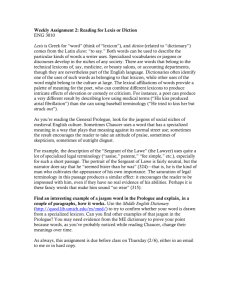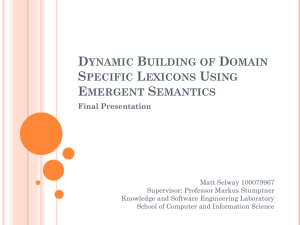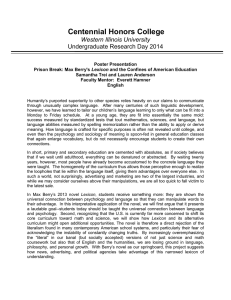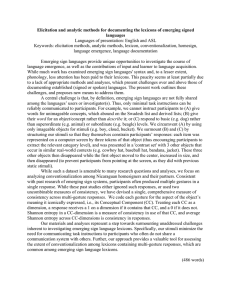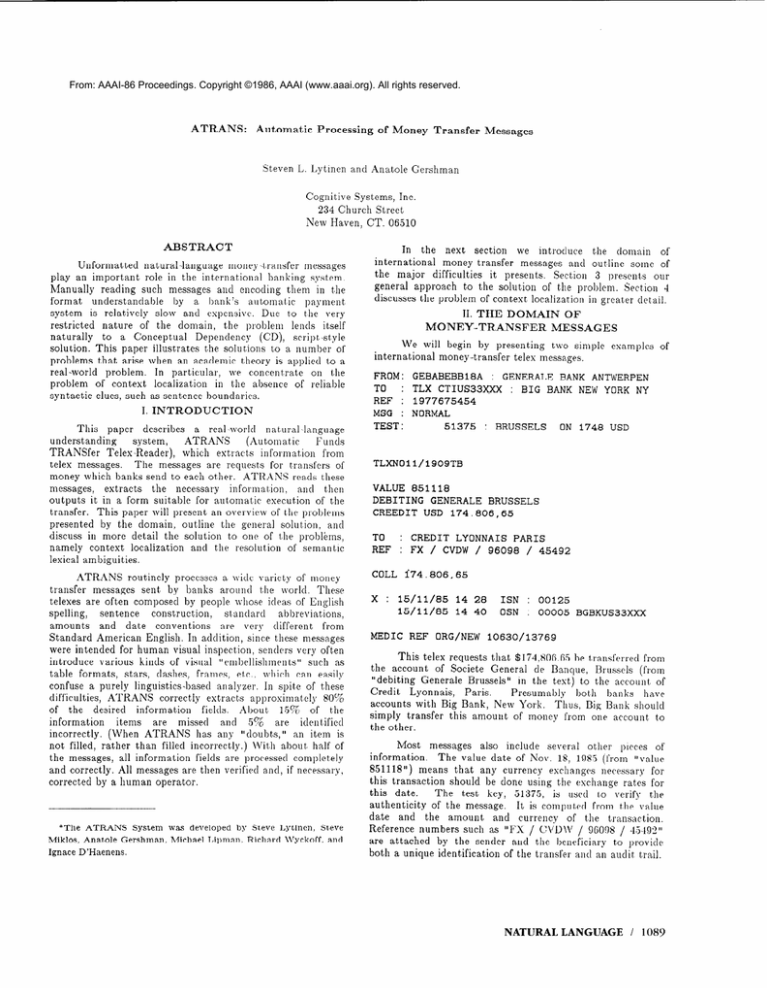
From: AAAI-86 Proceedings. Copyright ©1986, AAAI (www.aaai.org). All rights reserved.
ATRANS:
Automatic
Steven
Processing
L. Lytinen
of Money
and Anatole
Transfer
Messages
Gershman
Cognitive
Systems,
Inc.
234 Church Street
New Haven,
ABSTRACT
CT. 06510
In the
next
section
we introduce
the
domain
of
international
money transfer
messa.ges
and outline
some of
the major
difficulties
it presents.
Section
3 prescnt(s
our
general
approach
to the solution
of t’he problem.
Section
4
discusses
the problem
of context
localization
in greater
detail.
Unformatted
natural-language
nioney.transfer
messages
play an important
role in the int~ernational
banking
system.
Manually
reading
such messages
and encoding
them in the
format
understandable
by a bank’s
automsl,ic
payment
system
is relatively
slow and espensive.
Due to the very
II. THE
DOMAIN
OF
restricted
nature
of the domain,
the problem
lends
itself
MONEY-TRANSFER
MESSAGES
naturally
to a Conceptual
Dependency
(CD),
script,-st,yle
We will begin by present,ing
two simple
examples
solution.
This paper illustrates
the solutions
to a number
ol
international
money-transfer
telex messages.
problems
that arise when an acaclemic
theory
is applied
to a
real-world
problem.
In particular,
we concentrate
on the
FROM: GEBABEBB18A : GENERALE BANK ANTWERPEN
problem
of context
localization
in the absence
of reliable
TO
: TLX CTIUS33m
: BIG BANK NEW YORK NY
syntactic
clues, such as sentence
boundaries.
I. INTRODUCTION
This
paper
describes
a real-world
natural
language
understanding
system,
ATRANS
(Au tom at ic
Fu11ds
TRANSfer
Telex-Reader),
which
extracts
information
from
telex messages.
The messages
are requests
for transfers
of
money which banks send to each other.
ATRANS
reacls these
messages,
extracts
the
necessary
informa Iion,
and
t311cn
outputs
it in a form suitable
for autJomatic
execut8ion of the
transfer.
This paper will present
an overview
of t)he problems
presented
by the domain,
outline
the general
solution,
and
discuss
in more detail
the solution
to one of t)he problkms,
namely
context
localization
and the resolution
of semantic
lexical ambiguities.
ATRANS
routinely
processes
a wide variety
of money
transfer
messages
sent, by banks
around
t#he world.
These
telexes are often composed
by people \vhose ideas of English
spelling,
sentence
construction,
st)andard
abbreviations,
amounts
and
date
conventions
are VCI‘\’ different
from
Standard
American
English.
In addition,
sil;ce these messages
were intended
for human visual inspection,
senders very often
introduce
various
kinds of visual
“cml)ellishinents”
such as
table formats,
stars,
dashes,
frames,
et,c., which can easily
confuse
a purely
linguistics-based
analyzer.
In spit#e of these
difficulties,
ATRANS
correctly
extract,s
approximately
80%
of the
desired
information
fields.
About
15%
of the
information
items
are
missed
and
5%
are
identJifiecl
incorrectly.
(When ATRANS
has any “cloul~t~s,”
an item is
not filled, rather
than filled incorrectly.)
With sbout~ half of
the messages,
all information
fields arc processed
completely
and correctly.
All messages
are then verified and, if necessary,
corrected
by a human operator.
*The ATRANS System was developed by Steve Lytincn,
Steve
h/liklos, Anatole Gershman,h4ichael Lipman. Richard 1Vyckoff, and
Ignace D’Haenens.
REF : 1977675454
MSG : NORMAL
TEST:
51375
: BRUSSELS
of
ON 1748 USD
TLXN011/1909TB
VALUE 851118
DEBITING GENERALE BRUSSELS
CREEDIT USD 174.806,65
TO
REF
: CREDIT LYONNAIS PARIS
: FX / CVDW / 96098 / 45492
COLL f74.806,65
x : 15/11/85 14 28
15/11/85
14 40
MEDIC REF ORG/NEW
ISN : 00125
OSN : 00005 BGBKUS33XXX
10630/13769
This telex requests
that $174,806.65
be t,ransi’errecl
from
the account
of Societe
General
de Banclue,
Brussels
(from
“debiting
Generale
Brussels”
in the test) t)o the account) of
Credit
Lyonnais,
Paris.
Presumably
both
banks
have
accounts
with Big Bank, New York.
Thus, Big Bank should
simply
transfer
this amount
of money
from one account,
to
the other.
Most
messages
also include
several
other
pieces
of
information.
The value date of Nov. 18, 1085 (from “value
851118”) means that
any currency
exchanges
necessary
for
this transaction
should be done using the exchange
rat)es fol
this date.
The
test
key,
51375,
is used t,o verify
the
authenticity
of the message.
It is computed
from the value
date
and
the amount1
and
currency
of the transaction.
Reference
numbers
such as “FS / CVD\V / OG008 / -1.5-192”
are attached
by the sencler ant1 the beneficiary
to provide
both a unique identification
of the transfer
and an audit trail.
NATURAL
LANGUAGE
/
1089
All of this information
is conveltcd
by ATRANS
into a
standard
format,
from which it, t,hen gencralcs
an out,put,
format
appropriate
for
the
client’s
payment
processing
system.
The following
is a fragment, of (he s~antlard
format!
for the above message produced
by ATR,INS.
Test
key:
Amount:
Currency :
Value Date :
Sender name :
Sender city:
Sender ref:
Beneficiary
ref:
Credit party account:
Credit party name:
Credit party city:
Debit party account:
Debit party name:
Debit party city:
51375
174806.65
USD
Nov. 18, 1985
General Bank
Antwerpen
TLXN011/2909TB
FX/CVDW/96098/45492
12345678
Credit Lyonnais
Paris
87654321
General Bank
Brussels
What is required to process a message such as the above
example?
First,
most messages
contain
a great
deal of
irrelevant
information.
In this telex, there arc strings
of
characters
identifying
telex lines,
message
numbers,
etc.
Some messages even contain greet,ings from telex 0perat)ors or
other irrelevant
text.
The program
must,, t,hcrcfore, be quite
robust,
capable of accounting
for, or ignoring,
every word in
the input.
Lexical access in the system must, also be very robust.
First, words are sometimes
misspelt), such as “creedit,” above.
Second, the names of banks and customers
are often given in
The above message
the messages
in non standard
ways.
mentions
“Generale
Brussels, ‘I which refers to a bank in
Generale
de Banque. ”
Brussels
whose full name is “Societe
The same bank is also often referrecl t,o as SGB. The syst)em
must be able to identify
which bank is rcfcrrecl t#o by t#hese
non-standard
names.
The problem of bank ancl customer
name recognit,ion
is
There are many variations
of what constitutes
very serious.
the “standard”
name of a bank. The “standard”
name of the
New York branch of Barclays Bank is “Barclays
Bank of New
York”
which is rarely used by telex senders.
Instead,
we
often see something
like “Barclays,
New York.”
The Flemish
branches
of Societe Generale
de Banque are called Generale
Bankmaatshappij,
the British Commonwealth
branches of the
same
bank
are called
Belgian
Bank,
and
the German
In most cases, people will use the
branches,
Belgische Bank.
name of the bank that is most common in their own country.
Thus, a beneficiary
of a transfer
may be specified as “Societe
Ge.nerale
de Banque,
Antwerpen,”
even though
the teles
receiver’s database
does not list a bank under t#hat name in
Antwerp.
This problem
is compounded
by the fact that! t#here is
no single complete
database
with “st8anclard”
bank names.
Each bank uses its own, which in most cases was originally
designed
for mailing
purposes
and was typed in by several
generations
of secretaries.
(In one such database,
we fount1
about 1200 entries beginning
with “TO: I’. A typical large
bank’s
database
of corresponding
banks
ant1 commercial
customers
contains anywhere
from 20,000 to 40,000 entries.)
Messages
are often
ungrammatical
and are usually
written
in one very long sentence,
which gives no clues as to
Ill
where different
sections
of the message begin and end.
addition,
the input often contains
ambiguous
lexical it,ems.
1090
/ ENGINEERING
In this example,
both the recipient, of t,hc telex message (Big
of t,he t,ransnct ion (Credit
Bank)
and
the
beneficiary
Lyonnais)
are marked by the worcl “to.”
Similarly,
t,he word
“credit”
is used as a synonym
for t,he word “pay,” but it. also
appears
as the first word in the name of a bank. Similar
expressions
are interpreted
differenlly
depending
on where in
the telex they are encountered.
The way in which numbers should bc int.erpret,ed in this
After the word “value,”
the program
message
also varies.
“851118” as a (late (Nov.
must know to interpret
the number
18, 1985). However, if the same st,ring of numbers appeared
t#hen it
after a currency
type, such as “USD” (U.S. Dollars),
would
be interpreted
as an
amount,
or
$851.118.00.
Similarly, after “ref,”
number
follows,
copied verbatim
which intlicates that, n reference
numbers
must simply be t,reat,ecl as strings,
into the reference field.
The above examples
show that even in such a narrow
domain
as money-transfer
telexes,
a test, unclel~stnnclin,rr~g
system
must
show
a great, deal of flesibilit~,
both
in
tolerating
the appearance
of lexical items in the tscst \\hich
are unknown
to the program
and in determining
when known
words or phrases are misspelled or referred to in noli-standard
ways.
In addition,
the extraction
of standard
fields fol
money transfers
must proceed without! explicit cues, such as
separate
sentences,
that might indicate
lvhere the fields can
be found,
and must take place in the presence
of lcsical
ambiguities
that can complicate
t(he process.
III. HOW
ATRANS
WORKS
To deal with the problems
outlined
in the last section
effectively,
ATRANS
uses a knowledge
based approach
to
text analysis.
Although
the struct,ure
of t,elcs messages
CM
varv a great deal. their content
is very predictable.
\\-e can
use the predictability
of the content
to gllide the parsing
process and overcome
the problems we discussed earlier.
Much of ATRANS’ knowledge
of the input domain can
be organized
in terms of a script’ [9] or a standard
sequence of
actions which we can expect to occur in a money transfer.
The script is the following:
1. Customer
OC
(Originating
Customer)
in count,ry
A asks his local bank OB (Originating
Bank) to
M to a beneficiary
BC
send
some
money
(Beneficiary
Customer)
in count,ry B.
Bank OB asks a large internat,ional
bank
SB
(Sender
Bank
Bank)
in country
SB sends
reading)
a request
A to forward
t,he money.
(the
t!hnt we are
to its corresponding
Bank)
in country
Bank
RB
pays
(Beneficiary
the
Bank)
RB wants
According
bnnk RB (Receipicnt,
B.
money
with
customer
has an account.
Bank BB pays the beneficiary
Bank
pays.
message
t’o a local
whom
t(he
cust)omer
bank
1313
beneficiary
BC.
to be reimbursecl
for the money it
to the instructions
contained
in
the message,
it either debits SB’s account
with
itself, or waits until the money is credit,ed to one
of its accounts
Bank).
with
some
other
bank
CB (Cove1
There are a number
of variations
of the above script,
including
a number of intermecliary
banks, banks trading on
their own accounts,
different
methods
of payment,s,
etc. A
message
can also request
several
payments
to clifferent
beneficiaries.
raw unformatted
I
I message
I
I classifier I
--> +------------+
+------------+
I dictionI aries
+-----~~----~+
message
I
+----------+
I
I
-->
I text
I
I analyzer
I
+----------+
I
+a-a-----------+
+------------+
I message
I
I interpreter I
--> +---------------+
John
-->
1 output
I
I
+-----------+
1:
Structure
and Rlary
were
racing.
John
boat, n&.ry.
+--------es--+
I formatter
Figure
Now that we have given an overvicn’ of t,hc problems
which
must be solved
in order
t,o process
mcssagcs
in the
domain
of international
money t,ransfers.
1i.c \vill concenlr;lte
on l;he solution
of one of these problems:
context, localization
and,
in particular,
how
it is llsctlto resolve
lexical
ambiguities.
It is well known
that,
cont,est,
can often
eliminate
semantic
lexical ambiguities
in test,s.
\Vortls which in general
have many
different
meanings
often have only one possible
meaning
within
a limitecl
enough
contest,.
R iesbeck
[7]presented
the follo\ving
esample
of t,his situation:
I
I bank and
I
I customer dbl
+------------+
represented
internally
in what we call a Universal
hlessage
Format.
From
this format
the Ou t,puI Generator
produces
the output
in the form a.ppropriate
for the particular
user of
the system (e.g., SWIFT,
CHIPS, Fecl\vire).
IV. CONTEXT
LOCALIZATION
IN ATRANS
of the ATR.-\NS
System
The
ATRANS
system
consist,s
of four
parts.
as
illustrated
in figure
1.
The nlessage.classificn(
iou motlule
determines
the type of message
being processed
;~ncl cl~oo~cs a
variation
of the transfer
script, to be applied.
11’the nicssage
contains
multiple
transfers,
the moclulc~ iclc~ntifics the common
portions
of the transfer
and composes
several single t,ransrer
messages.
“Visual”
clues,
such
as table like illigllIllC2llt
of
amounts
and dates, play an important1
role in det,ernnining
if a
message contains
a request for multiple
payments.
The Text, Analyzer
is the heart
of t,he system.
It
processes
each telex from left to right, in a determinist~ic
manner,
producing
a
Conceptual
Dependency
(CD)
representation
[8] of the telex content8.
The Analyzer
follows
the general
line of semantically-hased
predict,ive
conceptual
analyzers
(for details,
see [7], fl],
[s],and (‘;I).
The basic
script for international
money t,ransfers
consist8s of a number
of frames, some of which can occur only in a prescribed
order
and some of which can occur anywhere
in t,he message
t,est.
Using the script,
the dictionaries,
and the context
localization
mechanism
(described
in the next) sect8ion),
t’he Analyzer
identifies
the frames
being
referred
t,o by the test
(e.g.,
payment,
test, cover,
etc.) and sets up espectalions
which
interpret
and ext,ract
informstion
items
completing
t’hose
frames (e.g., amounts,
dates, banks, etc.).
The same information
items can be specified
in different
places within
the same message.
For example,
the sender of
the telex can be explicitly
stst~ed in the beginning
of t,he
message
(e.g., “Mere is . ..I’ or “from . . . ‘I), al the end of the
message (e.g., ‘IRegards,
. . . I’), or as a telegraphic
answerback
ESTNCO
G”). s‘ome of this informat,ion
key (e.g., “918824
may not be 100% reliable,
as when the sender uses son~cbocly
else’s telex machine,
producing
a misleading
answerback
key.
However,
if different
passages
in the test
confirm
one
another,
we can conclude
with a high degree of confidence
that the telex was understood
correctly.
The Analyzer
does not verify the extracted
information
x check it for consistency.
This is the job of tthe hiessage
Interpreter.
It
verifies
and
consoliclates
the
extractfed
nformation
items, looks up in the data base the appropriate
sccount
numbers
and customer
addresses,
and decides on the
nost
appropriate
method
of
payment.
The
result
is
In general,
“beat”
has several meanings,
such as ‘1to hit
repeatedly,
I’ “to l>evictorious
in a compelition,”
or ‘I to mix
thoroughly”
(e.g., to beat, an egg). I-Io\ve\*car, in t,he coutcst
of
“racing,”
it is clear that “best)” means ‘I to he \*ictorious
in a
competit8ion.
I’
In script based systems,
part,icular
contests
“prime”
01
give preference
to part,icular
senses of ambiguous
words by
using what is called “scriptal
lexicons”
[2][3].In Llieabove
example,
the word
I’racing”
would
activate
espect,ations
associated
with the concept
of racing,
including
a specializecl
vocabulary
of “racing
terms”
in which
t,he \vortl
11beater
would have the single meaning
of IIto be yic t,orious. II
to
ATRANS
uses an estension
of the scriptsal
its expectations
and resolve smbiguilies.
focus
lexicon idea
Inst,ead of
associating
a scriptal
lexicon wit,11 a relat’ively
large script,,
ATRANS
uses a hierarchy
of local contexts,
each of which
uses a smaller
“context,ual
lesicon.”
As is t,he case wit’11 every
context-based
system,
the following
issues must, be acltlrc~ssecl:
1. What
is the
is activated?
2. How broad
mechanism
a range
context
prime?
3. How long should
we know
when
by which
of word
a context
the context
senses
be active
a local
contest’
should
a given
(i.e.,
how
do
has changed)?
To
bring
contextual
information
to bear
on
the
ATRANS
has ;tset of separate
resolution
of ambiguities,
lexicons,
each of which contains
clefinitions
for words or word
senses which
refer to a certain
class of objects
which
the
one of t!hc lexicons contains
program
must, find. For example,
Another
lexicon con t,ains definitions
of
only names of banks.
words
which
are likely
t,o appear
in addresses,
SUCK
xs
a,.g well
as names
of
cit,ies
and inforrrlati01l
>IbOllt,
“street,”
how to process
numbers
such as zip codes.
Other
lexicons
contain
only currency
types,
only words having
t)O Cl0 \vith
dates, or only non-bank
customer
names.
items are
lesical
single
lexicon,
Within
any
For example,
in the Address
lexicon, numbers
unambiguous.
are defined exclusively
as zip codes or street numbers,
not, as
In the Bank name
lexicon,
tlhe word
dates
or amounts.
“Credit”
is defined as the first word in t,he names of several
banks,
such as “Credit
Lyonnais,”
but not as meaning
the
same thing as “pay.”
During
the processing
maintains
a list of lexicons
of a telex message,
ATR.+1NS
The
which are current,ly
act,ive.
NATURAL
LANGUAGE
/
1091
system
has a set of rules which
delermine
when Lhis list
should
be altered,
either
by activat,iug
new lexicons
or de
pot clu t,inl
ThllS.
lesicons.
currently-active
activating
ambiguities
are resolved by virtue of which lexicons are active
For example,
it’ t,hcl Date
when the word is encountered.
lexicon is active,
"851113" is interpreted
a5 :I dl1te, because of
IIo\vc~~r,
if
the definition
of a number
in t#he Date lexicon.
t,he definition
of t,his same
the Currency
lexicon were active,
number
would be int,erpreted
as ” $851 ,113.OO. ” Similarly,
if
the Bank lexicon were active, the ivorcl “Credit’” WOUND cause
the parser
to try to match
the input
aga,inst
bank names
t;haii try to inkrpret,
the
beginning
with
“Credit, ‘I rather
word as meaning
“pay.”
The types
of lexicons
we have describccl
so far are
appropriate
when
context
predicts
that, a certain
type of
For esaniple,
after the
object will occur nest in the input.
phrase
“value date, ‘I it is very likely that’ a date will follow.
At, tliffercii t t’imes,
Thus
the Date
lexicon
is activated.
however,
the level of specificity
of the cspectat’ions
t’hat
Because
of t’liis,
context
can provide
varies
a great
deal.
ATRANS
also has a range of lexicons
which vary in their
level of specificity.
Because ATRANS’ job is to find the fillers of particular
fields in a telex message which correspond
to t’hc most, specific
lexicons
in the system,
more general
lexicons
exist solely to
determine
when contest
can be refined enough to activate
the
specific lexicons, For esample,
the most general lcsicon, called
the Telex lesicon,
contains
definitions
of words which mark
general
divisions
of the telex message,
such as the heading,
the body, and the sign.off.
This lexicon contains
words such
01’ a. mei;sage
as ‘Ifrom I’ and ‘Ito, “ which mark the beginning
header;
“pay”
and
“credit”
(the sense
meaning
“pay”),
which often mark the beginning
of the bocly of t,he message;
and words such as “regards,”
which
mark
the end of the
body.
Part of the definitions
of these words is information
that activates
more specific contexts.
For example, after t,lle
word I’pay, II it is likely that only ccltain
informat,ion
about
the transaction
will appear,
such as information
about, bhe
beneficiary
and intermecliate
banks.
Thus, one lexicon lvhich
“pay” activates
is the Pay lexicon, lvliich coiit,ains tlc~fiiiit,ions
of words such a~ “in favor of,” ‘1to” (meaning
l~beneficiaryl~),
“account,”
etc.
The definitions
of these
words
contain
information
which in turn causes more specific lesicons
to be
activated.
For instance,
since the beneficiary
is likely to
follow immediately
after “in favor of,” t)his phrase
ncIivat,es
the Bank lexicon and the Customer
lesicon.
Because
of the way in which
lesicons
in XTR.kNS
activate
each other,
they can be viewed
as being arranged
into a hierarchy.
Very general
lexicons
at’ the top of the
hierarchy,
such as the Telex lesicon,
contain
definit,ions
of
words
which
activate
lexicons
at the next
level of the
hierarchy,
such as the Pay lexicon.
These lexicons
in t>urn
contain
definitions
which activate
lexicons at, the nest, level
down.
This continues
down to lexicons at the bot)tom of the
hierarchy,
such as the Date lexicon,
the Ba,nk lexicon, et,c.,
which look for specific fields in the transaction.
We will now address
the problem
of what words should
be included
in a contextual
lexicon. Clearly,
the \vords which
directly
refer to the expected
concepts
should be included.
In
many
cases,
however,
the meanings
of words
which
only
indirectly
refer to expected
concepts
should
also be favorecl
over other meanings
of these words.
For example:
John
At
1092
went
this
to a restaurant.
point
in the
/ ENGINEERING
He ordered
sentence,
a rare
it is alreacly
..,
possible
to
disambiguate
“rare”
to mean
“not \vell douc”
rather
t,han
this word does not, refer to one
“highly
unusual. ” However,
of the roles or evenk
which
are explicit, in the restaurant
script.
It refers to a property
of food, which is an explicit
role-filler,
but does not refer clirectly to t,he food.
In the ATRANS
system,
t,his problem
is overcome
in
two ways.
First, lexicons which contain
word senses referring
to particular
objects
also contain
words referring
to related
concepts.
For example,
when mentioning
the reimbursement
account
for a transaction,
the telex message
will oft,en give
the type of account
or the branch of the sender bank to which
Thus in the Reimbursement
Iesicon,
the account
belongs.
although
the type of object explicitly
being looked for is an
account,
words and phrases
such as ” branch, ” “head office, ”
are
also
includc~tl
in this
lesicon.
“foreign
office”
and
Secondly,
lexicons
are often
paired
together,
so t,hat one
lexicon will always
be activated
whenever
another
lesicon is
For instance,
whenever
ATRANS
looks for a
activated.
customer,
both the Customer
lexicon and the Address
lexicon
are activated,
because
it is likely
that
an address
will
accompany
the customer
name in the kles message.
Finally,
we have to aclclress t,he issue of contc~st, de
activation.
Once a set of word senses is primed,
how long
should they stay primed?
For example:
John
mad
racing
means
and Mary
and beat
were
racing.
hlary
won.
.John got
her.
we must realize
At some point in this story,
context
no longer
applies,
and that “beat”
“hit repeatedly.
‘I
that the
t,hcrefore
The ATRANS
system uses the hierarchical
organization
.-it, all
of its lexicons
to determine
when to switch COiltf?XtS.
times,
the system
maintains
a stack
of previously
act,ive
lexicons.
This stack
is maintained
so (hat, the system
can
less specil’ic contests
\~hcn the
return
to previously-act,ive,
specific expectations
of currently
act,ive cont,est,s are uot, met.
Whenever
the Analyzer
encounters
a word
which
is not
but8
which
does
have
a
defined
in the current
contest
definition
in one of the previous
contest,s
on the stack,
the
Analyzer
abandons
the current
contest
and rcst,ores
the
previous
contest.
For example:
TO:
BIG
BANK,
NEW YORK
PAY USD 100,000
IN FAVOR
ACCOUNT WITH YOURSELVES
OF BANK A
IN COVER OF CREDOC #133563
REGARDS,
BANK B
NEW YORK
The phrase
“in cover of” activates
a set of lesicons usecl
to find information
about
reimbursement,
for the recipient
bank.
This set of lexicons
includes
the Bank lesicon,
which
contains
bank names.
However,
in this particular
message,
no information
about reimbursement
is given.
Therefore,
the
Analyzer
needs
to know
when
t.0 stop
looking
for t,his
information.
When
the worcl
“regards”
is reached,
the
Analyzer
knows
that
the reimbursement
con test sl~oulcl be
abandoned
because
“regards”
is not clefined in any of the
currently-active
lexicons
but, is defined in a I>reviously-nct.ive
lexicon,
namely
the Telex lexicon, which contains
definitions
of words which mark different
sections
of the telex message.
Because
of this, the context
in which t,he Teles lesicon \vas
active
is restored,
thus de-activating
the cont.c~st set up by
“in cover of. ‘I In this case, since the tc>les contest,
\vllich is
I-e-activated
was active several
contexts
ago, t,he popping
of
the context
stack
also eliminates
the possiI)iIit,~~ that, other,
more recently-active,
contexts
might be rc-nctivatd,
such as
the ‘Ipay” context
which looks for phrase:, such as “in favor
etc.
of, ‘1 “account,”
V. CONCLUSION
l\‘e
have
presented
a
lillo\\klg-e
1,ahrcl
tcstc
understanding
system
which processes
telcs mehh;~gcs rcIinl)I>
and robustly
in the cloma.in of intcrnnt ion;11 money t r;~nst’crs.
Although
the input messages
are noisy. including
irrclcvant
text,
misspellings,
non standard
references
to bnnlis.
and
many ambiguities,
the system’s
use of I;nol\~lctlge about
t,Ile
domain
allows it, to extract
the iniport,aiit,
informat,ion
in R
robust manner.
We have presented
in detail t,hc solution
to one of t,Ile
issues that
must
be faced
in such
a s!~slern,
namely
[,]ie
resolution
of lexical ambiguities.
ATR.4KS
takes
acl\.anhge
of the fact that, in some contexts,
lvortls which in general are
ambiguous
can be treated
as if tlicby have only one rnenning.
Although
the structure
of telex
messages
gi\.es
us few
contextual
clues, ATRANS
is able to u>e its kno\vlcclge
of t,Ile
domain
to determne
when
part2icular
contesh
should
be
activated
or de-act,ivat,ed.
To
decide when a particular
lexicon or it
of lexicons
should
be activated,
lexicons
in ATRXKS
arc arranged
hierarchically.
Thus, when expect ations provitlCd by contest,
are very general,
very general lexicons are uhcd I,)- t,he sl,stem.
As context
creat,es more specific
espec ta t ions, more specific
lexicons are activated.
This approach
also provides
a nat,ural
solution
to the problem
of knowing
when t,o de activak
a
A st,ack
of previous
cont;csts
is
particular
context.
Whenever
a word Or phrase which
maintained
by the system.
was defined
in a previous
context
but not, in the present
context
is encountered,
this is taken
as a signal
that
the
present context
should
be abancloned
ant1 the prei,ious
In this wan, the system
is
context
should
be re-activated.
able to de.activate
specific
expect,ations
a1 the approprint’e
times, and fall back on previously
active general expectations
to determine
lvhat the next cont,est8 in the message shoul~l be.
REFERENCES
1.
Birnbaum,
L., and Selfridge,
&4. Problems
in Conceptual
Analysis
of Natural
Langua,ge.
168, Yale lTniversit1
Department
of Computer
Science, Oct,ober.
1979.
2.
Charniak,
Program.
E.
Conference
International
-4 Language
of the Fifkh
h/Iass.,
Cullingforcl,
August,
R.
University,
1978.
4.
G.
DeJong,
Script Application:
Th.,
Stories.
Research
Report8
Skimming
Stories
Compufe,
Ph.D.
‘I’ll., Yale
#llS.
iu Real Time: Au
in Itttegrnted lJntlelsttr)2[li)l.g. Ph.D.
h4ay 1979. Research
Report #151.
Th.,
Yale
In depth U~zdersinndiug: A Computel* AIodel
Processing for Narrati~~e C'o~~bprehe,lsio,z,
5. Dyer, h4.
of Integrated
Ph.D.
Joint
1977.
U~zderstn?adiszg o-f i!Tewspaper
Experiment
University,
C’omprchcnsion
Int,ernntional
on Artificial
Intelligence,
Proceedings
of t,hc Fifth
Joint Conference
on Artificial
Inkelligence,
Cambridge,
3.
h4s. Rlalaprop:
Proceedings
Yale University,
h4ay
1982. Research
Rcpolt
#219.
6.
Gershman,
A.
Yale University,
7.
Riesbeck,
C.
Infornzation
8.
Schank,
Knowledge
1979.
Conceptual
Processing,
R.C.
Natural
Language
4 (1972), 552-631.
based Parsing.
Research
Report
9. Schank,
R.C. and Abelson,
R..
Understanding.
Lawrence
Erlbaum
New Jersey,
1977.
10.
Young,
S. and Hayes,
Amst,erdam,
Dependency:
Understancling”
P.
Th.,
In Concept utrl
Analysis.
North-Holland,
“Conceptual
Ph.D.
#lSG.
1975.
A Theory
. Cog,lifiue
of
Psychology
3,
Scripts, Plans, G’oals and
Associates.
Hillsdale,
Automatic
Classification
and
Summarization
of Banking
Telexes.
Proceedings
of the
Second Conference
on Artificial
Intelligence
AppIica.tions,
IEEE
Computer
Society,
December,
1985.
In addition
to benefits
in performance,
t’he MC of local
lexicons in ATRANS
proves to have orgnnizat,ionaI
bcncfits
as
Because
the system
uses local
contexts,
diffcrcnt
well.
programmers were able to develop parsing rules for different
contexts
independently.
In contrast,
to other
message parsing
systems
such as
which
concentrat,e
primarily
on
FRUMP
[4]or TESS [lo],
message classification
and summarization,
ATliANS
carefully
analyzes
every word in a message,
producing
a highly detailed
To the best of our kn~~lcclge,
representation
of its content.
ATRANS
is unique in its robust coverage
of a domain
at this
level of detail.
Finally,
we
offer
some
in~plementntional
details.
ATRANS
is currently
undergoing
live testing
at n majol
international
bank.
The system
is impIemcnt~ed
in the T
dialect
of LISP under the VAX/Vh4S
operating
systrm.
The
average
processing
time on a VAX 11/785 is unclcr SO seconds
per telex.
NATURAL
LANGUAGE
/ 1093

